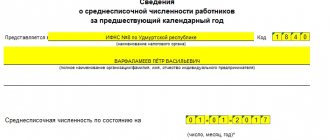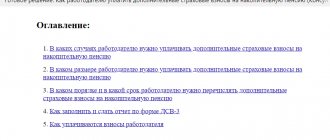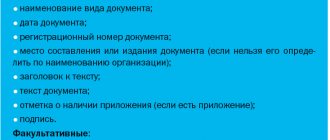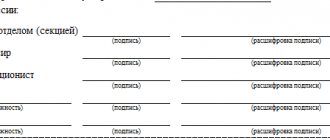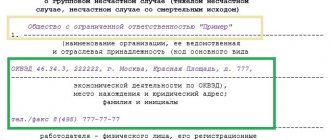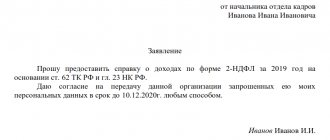Features of the help report
The cashier-operator's certificate-report has several characteristic features:
- the KM-6 form, approved by the State Statistics Committee of the Russian Federation in 1998, is unified;
- errors when filling out, as well as deviations from the generally accepted format, may result in a fine during the work of inspection bodies;
- KM-6 must be filled out daily (or at the end of each shift), and simultaneous filling out of certificates for 2 or more days/shifts is not allowed;
- The document must be submitted simultaneously with the proceeds - either to the chief cashier of the company or to the bank;
- The certificate must be kept for exactly 5 years, after which it loses its value.
Important! Column 4 is filled in only when using outdated cash register equipment. If modern devices have been installed in the organization over the past 12 years, then this section should be left blank
Form KM-7 for cash transactions
There should not be any difficulties in filling out the KM-7 form, the main thing is to be careful. In order for you to have all the necessary data on hand, you need to know the information from the operator’s reports. Each report has its own number and date. The following rules must be taken into account when filling out the document:
- The name of the organization, TIN, address, as well as the location of the unit, if any, are indicated.
- The date must be specified, with the time specified in minutes.
- A serial number, which is indicated in accordance with continuous numbering.
- It is necessary to give information about the cashiers' report numbers, along with the dates. The combined form must also be indicated.
- KKM numbers and other distinctive features, of which there may be several, are indicated. All this is indicated on the reverse side.
- There must be information about the control counter reports, information about the fiscal memory report, where you need to indicate its number. All this is entered in the appropriate columns. Counter data is indicated both at the beginning of the day and at the end.
- Total revenue per shift, which needs to be broken down by department.
- If there is an amount that was returned due to some circumstances to buyers, this must be recorded in a separate line in words.
- Everything is certified by the senior cashier, where it is necessary to decipher the surname. The completed form must be attached to the KM-6 report.
Now, using special computer programs, you can obtain all the necessary information related to meter readings. Most organizations must have a document called a “certificate-report of the cashier of the operator.” Such a document will most likely be required if the retail outlet has a registered cash register with fiscal memory. All the necessary information is taken from this document, and it is on its basis that the necessary document can be drawn up.
Information about the readings of KKM counters, form KM-7
Every day at the end of the working day, the cashier must fill out a number of documents; if the organization has several cash registers, then one of the mandatory reports is Information on the readings of cash register counters, form KM-7. This form is a summary report that reflects data on all available cash registers. In this article we will analyze the design of this document. The KM-7 form itself can be downloaded below. As an example, we filled out information about the readings of cash register counters; a sample can be downloaded below.
By the way, if the company has only one cash register, then the cashier needs to fill out a certificate-report of the cashier-operator instead of the KM-7 form.
Daily mandatory cash reports also include a journal in the KM-4 form.
The unified form KM-7, which is used for filling out, was approved by the State Statistics Committee of Russia dated December 25, 1998 No. 132.
Application of the KM-7 form
In cases where an organization operates several cash registers at once, then a unified KM-7 form is required. This form helps to compile a consolidated report on information about the income of a legal entity from all cash registers used. Moreover, the report is drawn up for the current day of the organization’s work.
The senior cashier prepares one copy of the KM-7 form and, together with other reporting documents, sends it to the accounting department at the end of the work shift. Form KM-7 indicates information for each cash register at the beginning of the work shift and at its end. The amount of revenue is certified by the signature of the head of each department.
The organization's total revenue is entered in a special field on the KM-7 form. The information specified in the document makes it possible to evaluate the efficiency of the enterprise. The distribution of funds among departments of the organization also occurs based on the daily reporting table. Indications from cash registers must be signed by the senior cashier, as well as the head of the organization.
What are the features of filling out a report on form KM-7
Form KM-7 had to be generated daily in 1 copy and submitted to the accounting department before the start of the next work shift together:
- with form KM-6;
- PKO, RKO;
- acts in the KM-3 form (for the return of funds to customers).
The table, which is the main element of the KM-7 form, indicated and summarized the indicators for all fiscal counters of cash register systems, as well as for cash revenue for the trading entity as a whole or broken down by department (in this case, the figures were certified by the signatures of the heads of the relevant departments).
The amounts reflected in the acts in the KM-3 form, that is, returned to the company’s buyers, were indicated in words in a special column located under the table.
The information recorded in the KM-7 form was certified by the head of the trading entity, as well as by the senior cashier.
Read about the KUM-3 form in the material “Unified form No. KM-3 - form and sample” .
How to correctly fill out a materials acceptance certificate
At the top of the act, the names, addresses, telephone numbers, sender, supplier and recipient of the materials are indicated, as well as the place where the act was drawn up, the start and end time of acceptance. If the cargo was insured, then the insurance company is indicated. In addition, the corresponding lines indicate the number of the quality certificate, the number and date of the accompanying document (invoice), the number and date of the contract for the supply of materials.
On the 1st page of the form, in the section “According to the accompanying transport documents,” the data from the supplier’s invoice is indicated.
On the 2nd page, the storage conditions of the products at the recipient's warehouse, the condition of the containers and packaging of the products are written. It also indicates how the quantity of missing products was determined.
On the 3rd page of the act, the identified information about defects, damage, shortages and surpluses of materials with the exact quantity and cost is indicated.
The 4th page contains the conclusion of the acceptance committee and lists the documents attached to the act.
Note! The act is drawn up by the commission in two copies with the obligatory participation of the financially responsible person and the supplier’s representative. Each member of the commission, including the storekeeper receiving materials, signs the act
The act is approved by the head of the organization receiving the materials.
Filling out the KM-2 form
Details of the sender - the owner of the cash register
The first part of the document includes information about the company that owns the cash register that requires repair.
First, enter the full name of the enterprise indicating its organizational and legal status (IP, LLC, CJSC, OJSC), as well as its address and telephone number (this information is needed in case the regulatory authorities have questions in the future, and mobile or landline indicate the number - there is no difference).
Nearby, in the appropriate cells, you need to enter the OKPO code (contained in the registration documents of the individual entrepreneur or legal entity), the code of the type of activity according to OKVED, as well as the TIN of the individual entrepreneur or organization. If the cash register belongs to a structural unit, you must indicate it too, with the full name and address of its location.
Next, the name of the cash register (according to the passport) and the number assigned by the manufacturer are entered in the required line - here you need to put the serial number of the cash register (usually it is indicated on the cash register case or on the box). Next to it should be noted the name of the applied accounting computer program that is used in the organization (usually these are different versions of 1C). Then in the “Document Number” cell you need to enter the corresponding number, and in the “Date of Compilation” line - the date of registration of the cash register with the territorial tax office (exactly the date of registration of the cash register for tax purposes!)
At the same time, it is important to remember one subtlety: the date of drawing up this act should be no earlier than one day before the registration of the cash register with the tax service (it is better to enter it after taking meter readings)
Reasons for submitting the cash register for repair
The next part is the main one and concerns the specific reasons that served as the basis for submitting the cash register for repair. In the “Nature of the malfunction” item, you must enter the reason for the breakdown of the cash register or write “the ECLZ has expired” (in the event that the ECLZ unit needs to be replaced).
Then you should enter the meter readings before sending the cash register for repair.
Maintenance specialists will do the same after the repair work has been completed.
In line A “Before sending for repair” and “When returning the car after repair to the organization”, you must enter the numbers of the Z-reports taken, in line B - specific monetary amounts (they must be entered both digitally and in writing)
Signatures of the parties upon acceptance and delivery of cash registers
The third part of this document includes the signatures of all interested parties, namely:
- tax inspector;
- director of the enterprise;
- senior cashier;
- cashier;
- representative of the service center with whom the company that owns the cash register has signed a maintenance agreement.
All signatures must be decrypted. Opposite the name of the tax inspector, you need to indicate which tax service he belongs to (all the same things will need to be included in this act when returning the cash register from repair). After the act in form KM-2 is duly drawn up, it must be submitted to the Federal Tax Service at the place of state registration of the owner of the enterprise in order to obtain permission to replace or repair the EKLZ.
Form KM-7: form
The unified form KM-7 was developed by Goskomstat. He assumes that the form consists of two parts: a “header” and a table where indicators for each cash register operating at the enterprise are entered in a separate line.
The header of the report contains the following information:
- information about the organization (its name, legal address and telephone number);
- INN of the company or individual entrepreneur and OKPO code;
- OKVED code (main activity of the business structure);
- name of the structural unit (if any are allocated within the company);
- report number and date of its preparation;
- time of report generation;
- numbers and dates of KM-6 forms on the basis of which the report was compiled.
Mandatory rules in force until 2021 assumed that KM-7 had continuous numbering, which was not interrupted with the beginning of the new year. For example, if the report for December 31st was numbered 101, then the form completed on January 1st will be 101st, not 1st.
The second part of the unified form is a table with data for each cash register. It includes the following columns:
- line number in order;
- factory and registration number of the cash register;
- control meter readings (registered in the Z-report);
- readings of cash counters, determined by cumulative total at the beginning and end of the shift;
- revenue (defined as the difference between the two previous columns);
- revenue values by department;
- signatures of department heads.
Below the table was the total amount of revenue and returns made to customers (this amount was taken from the KM-3 form).
The main feature of the KM-7 form is its consolidated nature. It was mandatory for companies and individual entrepreneurs that had several cash registers. If an organization had only one cash register, the form was not filled out; the tax authorities only needed the KM-6 report.
In 2021, firms have the right to choose whether to use KM-7 and under what conditions. The form used by the company for internal needs is fixed by its local regulations, and a list of persons responsible for drawing up the report is also given there.
Sample filling KM-7
At the beginning of the working day, the cashier servicing the cash register enters into the KM-7 form data on the name of the organization, its address, tax identification number, telephone number. The KKM model is also indicated, for which information is filled out in the KM-7 form, not only the name of the model is written, but also the passport number, the number received when registering the KKT with the tax office.
The cashier responsible for conducting operations with this cash register and filling out information on the KM-7 form must write his full name and the exact wording of the position. This cashier is responsible for the information provided and for all transactions carried out in the cash register for the specified period. The duration and time of the work shift are also prescribed at the top of the KM-7 form. The document is assigned a number and the date of completion is written.
The table displays data on cash registers for a work shift; the following data should be entered into it:
- number of the fiscal report at the end of the working day;
- information about cash meter readings at the beginning and end of the work shift;
- daily revenue as the difference in meter readings;
- distribution of revenue by departments (if any);
- information about checks returned by customers, as well as incorrectly entered ones;
- signature of the senior cashier and the head of the organization.
An example of filling out KM-7 can be downloaded below.
for free
Information about the readings of KKM counters, form KM-7 form - download.
Sample filling KM-7 - download.
Lifting equipment in Perm.
Answers to questions on the topic: Form KM-7
Hello! Please tell me how to correctly fill out the KM6 form, if for example, at the beginning of the shift (column 5) - 5.00, at the end of the shift (column 6) - 12.00, in column 7, respectively - 7.00, but in these 7 .00 is included in the terminal - 2.00, so what amount should I put in column 7? And then how to fill out KM7? Thank you in advance!
Olga
Monday, October 01
Hello Olga! In the Total revenue line in the amount of the certificate-report of the cashier-operator KM-6, exactly the revenue deposited at the organization’s cash desk minus cash returns is entered. That is, only the actual amount of cash in the cash register at the end of the working day (shift). Cashless payments are not related to the KM-6 form. Form KM-6 Certificate-report of cashier-operator, the cashier, together with the revenue, submits the receipt order to the cash desk of the enterprise's accounting department. Form KM-7 Information about the meter readings of cash register machines and the organization’s revenue is an appendix to the Cashier-Operator’s Certificate-Report (Form KM-6) and is stored with it in the archives of the enterprise in ANY form convenient for you.
Tuesday, October 02
Artem
Thursday, January 20th
Information about the meter readings of cash registers and the organization's revenue in the KM-7 form is used to compile a summary report on the meter readings of cash registers and the organization's revenue for the current working day and is an appendix to the Certificate - report of the cashier - operator for the current date. OKUD form code 0330107.
It is compiled in one copy by the senior cashier daily and, together with acts, certificates - reports of cashier -operatorists, parish and expenditure orders are transferred to the organization’s accounting department before the work of the next shift.
In the form, according to the meter readings at the beginning and at the end of work, revenue is calculated for each cash register machine, including its distribution among departments, which is confirmed by the signatures of the relevant department (section) heads.
At the end of the table, the meter readings of all cash registers and the total revenue of the organization are summed up with its distribution by departments (sections).
According to the acts, the total amount of money issued to buyers (clients) based on the cash receipts returned by them is indicated, by which the total revenue of the organization is reduced.
The information is signed by the head and senior cashier of the organization.
Report of the cashier-operator according to the KM-7 form
This document reflects data for each specific cash register.
The KM-7 form includes information about meter readings at the beginning and end of a certain time period, as well as about the total revenue received from this cash register.
Form KM-7 is submitted to the accounting department daily along with a certificate-report of the cashier-operator KM-6, the form and sample of which can be downloaded here.
Cashiers are also required to enter data into the KM-4 journal on a daily basis, a sample of which can be downloaded here.
Information about meter readings entered in the KM-7 form is transferred to the accounting department along with accompanying documents justifying the cash register's revenue - receipts and expenditure documents. Revenue from the cash register is transferred with the execution of a cash receipt order.
The KM-7 form and a sample of filling out information can be downloaded for free in Excel format at the bottom of the article.
Filling out the fields of the KM-7 form
The header must contain the details of the company. In this case, the name may be incomplete, and the structural unit may not be indicated. The numbering of the form is established by the enterprise. It maintains end-to-end order even after changing the calendar year, i.e. if on December 31 it was KM-7 No. 342, then on January 1 it will be No. 343, and not No. 1, as one might assume.
KM-7 hat
The KM-7 header can be said to be filled in in a standard way. The organization's data, name, address, and all its digital characteristics are entered:
Filling out the tabular part of the KM-7 form
- The table must include cash register numbers, which are entered in columns 2 and 3.
- The value for column 2 can be clarified in the vehicle passports, and 3 - in documents from the tax office regarding the registration of cash register equipment.
- Column 4 contains the report number Z. Entrepreneurs are familiar with such cases when, after removing this report, they had to open the cash register again and carry out transactions. If this happens, in the fourth column we indicate the number of the last Z report.
- Revenue for the day (columns 8-14) is posted by sections. If the department has more than 3 sections, several forms must be filled out.
- In boxes 10, 12 and 14, section leaders will need to sign to confirm that the information entered is correct.
If the enterprise does not have departments, columns 9-14 remain blank.
At the bottom of the form, fill in the amount of returns on checks for the day, including those that were entered by mistake. Enter the number in words, without duplicating it with numbers. Only the amount that buyers received in cash is entered in the field. Cashless returns are not taken into account.
We remind you that the KM-7 form is submitted in a single copy per day. If during the inspection the tax inspector discovers the absence of a document, fines will be imposed on the company and the responsible person.
Rules for filling out a report line by line
The form is filled out in the following order:
- Cap – indicate:
- name of the organization and contact details;
- if available, the name of the structural unit;
- OKPO, INN, activity code;
- cashier-operator number for the past day;
- form number, date and time of filling it out.
Table part:
- cash register numbers;
- equipment serial number;
- cash desk numbers assigned upon registration in the TIN;
- number at the beginning and end of the Z-report shift;
Important: the 5th column is not required to be filled out today, since modern machines do not reset their counters to zero at the end of the working day.
- meter readings at the beginning and end of the work shift;
- cash register revenue including returns;
- if there are departments, data for each separately with the certifying signature of the responsible persons. If there are no departments then columns 9 – 14 remain untouched.
At the end of the form, you need to add a total for the store and for each department individually.
Important: if there were returns or unused checks, you must add the total amount at the end of the form and indicate it in words. Based on the results of filling out, the form must be signed by the cashier who compiled it and the head of the enterprise.
Sample report form according to the KM-7 form.
However, there are some peculiarities during and after the data entry process:
- the form is filled out once a day, at the end of the shift, in a single copy;
- it must be submitted with forms KM-6, PKO, RKO, acts in form KM-3;
- You need to enter data into the table for all fiscal cash register counters, as well as for cash. Here you will learn what to do if the fiscal drive breaks down;
- if there are more than 3 departments, several forms must be filled out;
- in the field for indicating return receipts, you must also indicate erroneously entered ones;
- Information is reflected only for cash amounts; for bank transfers it is not indicated.
Important: previously this form was mandatory; if at least one copy was missing during a tax audit, the company was liable.
Sample of filling out the KM-7 form.
Submission deadlines
The cashier-operator is required to submit a report to the accounting department before the start of a new shift, and it is filled out daily at the end of the shift.
Rules for the formation of KM-7
Until 2021, the following rules for compiling KM-7 were legally established:
- It was filled out by hand or using computer programs daily based on KM-6 forms handed in by cashiers.
- It was sent to the enterprise’s accounting department no later than the next business day.
- The data obtained after the Z-report was taken was entered into it.
- The information was printed on two sides of one A4 sheet.
- The information specified in the report was certified by the signatures of the responsible persons: the senior cashier and a representative of the company administration.
During the period when firms and individual entrepreneurs used cash registers equipped with EKLZ, drawing up KM-7 was a mandatory procedure. It could be requested by tax authorities who came to the organization to conduct an audit. The absence of completed reports resulted in the imposition of penalties on the legal entity.
In 2021, the KM-7 form lost its mandatory status, because control of cash transactions carried out by business entities is possible online. Companies and individual entrepreneurs have the right to continue to fill out the report on a voluntary basis. They can develop a different form of it, for example, compiling only revenue figures.
Tags: Form, accountant, tax, expense, Form

